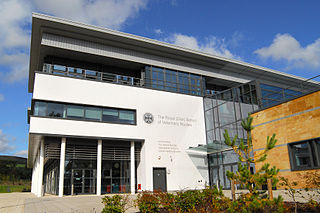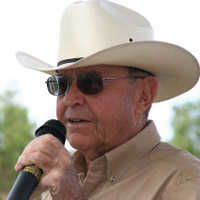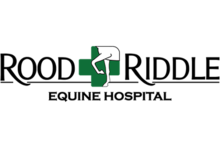
A gelding is a castrated male horse or other equine, such as a pony, donkey or a mule. The term is also used with certain other animals and livestock, such as domesticated camels. By comparison, the equivalent term for a castrated male bull would be ox, or a wether for rams and billy goats.

A veterinarian (vet) is a medical professional who practices veterinary medicine. They manage a wide range of health conditions and injuries in non-human animals. Along with this, veterinarians also play a role in animal reproduction, health management, conservation, husbandry and breeding and preventive medicine like nutrition, vaccination and parasitic control as well as biosecurity and zoonotic disease surveillance and prevention.

The Ontario Veterinary College (OVC) is the oldest veterinary school in Canada. It is located on the campus of the University of Guelph in Guelph, Ontario. The OVC is one of five veterinary schools that offer the Doctor of Veterinary Medicine, DVM program in Canada. The program is highly competitive and only admits a select number of applicants each year. The OVC was ranked 1st in Canada and 5th in the world for veterinary medicine by the QS World University Rankings 2020.
Emergency Vets is a reality television series that airs on the U.S. cable network Animal Planet. First aired in 1998, it depicts the working and outside lives of the veterinarians at Alameda East Veterinary Hospital in Denver, Colorado, USA, plus the animals that they treat. At its peak of popularity, Emergency Vets alternated with The Crocodile Hunter as Animal Planet's most popular show.

The New York State College of Veterinary Medicine at Cornell University is a college of veterinary medicine at Cornell University, in Ithaca, New York. It was founded in 1894. It is the first statutory college of the State University of New York (SUNY) system.
The Virginia–Maryland College of Veterinary Medicine is the veterinary school Virginia Tech and the University of Maryland, College Park - both of which are public research universities in the Commonwealth of Virginia and the State of Maryland, respectively.The college was created as a joint venture of the two universities and their respective state governments in order to fill the need for veterinary medicine education in both states. Students from both states are considered "in-state" students for admissions and tuition purposes.
Colic in horses is defined as abdominal pain, but it is a clinical symptom rather than a diagnosis. The term colic can encompass all forms of gastrointestinal conditions which cause pain as well as other causes of abdominal pain not involving the gastrointestinal tract. What makes it tricky is that different causes can manifest with similar signs of distress in the animal. Recognizing and understanding these signs is pivotal, as timely action can spell the difference between a brief moment of discomfort and a life-threatening situation. The most common forms of colic are gastrointestinal in nature and are most often related to colonic disturbance. There are a variety of different causes of colic, some of which can prove fatal without surgical intervention. Colic surgery is usually an expensive procedure as it is major abdominal surgery, often with intensive aftercare. Among domesticated horses, colic is the leading cause of premature death. The incidence of colic in the general horse population has been estimated between 4 and 10 percent over the course of the average lifespan. Clinical signs of colic generally require treatment by a veterinarian. The conditions that cause colic can become life-threatening in a short period of time.

Laminitis is a disease that affects the feet of ungulates and is found mostly in horses and cattle. Clinical signs include foot tenderness progressing to inability to walk, increased digital pulses, and increased temperature in the hooves. Severe cases with outwardly visible clinical signs are known by the colloquial term founder, and progression of the disease will lead to perforation of the coffin bone through the sole of the hoof or being unable to stand up, requiring euthanasia.

The Royal (Dick) School of Veterinary Studies, commonly referred to as the Dick Vet, is the University of Edinburgh's vet school. It is part of the College of Medicine and Veterinary Medicine.

Strongylus vulgaris, commonly known as the blood worm, is a common horse parasite in the phylum Nematoda. It looks like a long worm with a large biting mouth. They are usually reddish in color because of all the blood they take from the equine host. This nematode is considered to be one of the "most pathogenic" of the large strongyles subphylum and is distributed worldwide, wherever there are grassland and temperate environments.
Teuflesberg is an American Thoroughbred racehorse.

Veterinary chiropractic, also known as animal chiropractic, is chiropractic for animals – a type of spinal manipulation. Veterinary chiropractors typically treat horses, racing greyhounds, and pets. Veterinary chiropractic is a controversial method due to a lack of evidence as to the efficacy of chiropractic methods. Contrary to traditional medicine, chiropractic therapies are alternative medicine. There is some degree of risk associated with even skilled manipulation in animals as the potential for injury exists with any technique used. The founder of chiropractic, Daniel David Palmer, used the method on animals, partly to challenge claims that the placebo effect was responsible for favorable results in humans. Chiropractic treatment of large animals dates back to the early 1900s. As of 2019, many states in the US provide statutory or regulatory guidelines for the practice of chiropractic and related treatments on animals, generally requiring some form of veterinary involvement.

Robert M. Miller is an equine behaviorist and veterinarian, best recognized for his system of training newborn foals known as imprint training. Miller is also one of the early adopters and promoters of Natural horsemanship. His work is often referred to by natural horsemanship clinicians. He has served as a judge in the annual Road to the Horse competition, and also is a co-founder of the "Light Hands Horsemanship" concept and annual clinic.
Fleet Indian was an American Champion Thoroughbred racehorse. She was named American Champion Older Female Horse at the 2006 Eclipse Awards, an honor she is best known for.
Chelokee was an American Thoroughbred racehorse.

Veterinary medicine in the United States is the performance of veterinary medicine in the United States, normally performed by licensed professionals, and subject to provisions of statute law which vary by state. Veterinary medicine is normally led by veterinary physicians, termed veterinarians or vets, but also by paraveterinary workers, such as veterinary technicians, and veterinary assistants. This can be augmented by other paraprofessionals with specific specialties, such as animal physiotherapy or dentistry, and species-relevant roles such as farriers.

Milomir Kovac was a Serbian-German veterinary surgeon, equine specialist, columnist, and author of university textbooks.
The treatment of equine lameness is a complex subject. Lameness in horses has a variety of causes, and treatment must be tailored to the type and degree of injury, as well as the financial capabilities of the owner. Treatment may be applied locally, systemically, or intralesionally, and the strategy for treatment may change as healing progresses. The end goal is to reduce the pain and inflammation associated with injury, to encourage the injured tissue to heal with normal structure and function, and to ultimately return the horse to the highest level of performance possible following recovery.
Susan Marie Stover is a professor of veterinary anatomy at the University of California, Davis School of Veterinary Medicine and director of the J.D. Wheat Veterinary Orthopedic Research Laboratory. One of the focuses of her wide-ranging research is musculoskeletal injuries in racehorses, particularly catastrophic breakdowns. Her identification of risk factors has resulted in improved early detection and changes to horse training and surgical repair methods. On July 30, 2016, Stover received the Lifetime Excellence in Research Award from the American Veterinary Medical Association. In August 2016, she was selected for induction into the University of Kentucky Equine Research Hall of Fame.
Epicenter is a retired Champion American Thoroughbred racehorse. In 2022 he won the Risen Star, Louisiana Derby, Jim Dandy and Travers Stakes. He also finished second as the favorite in both the 2022 Kentucky Derby and Preakness Stakes.











